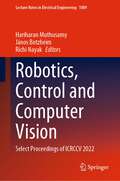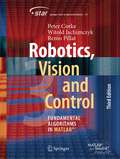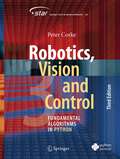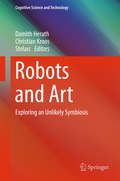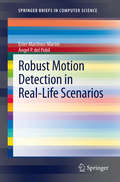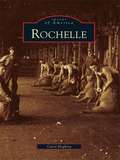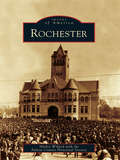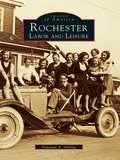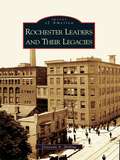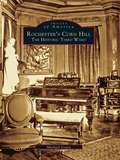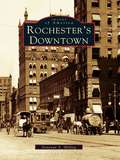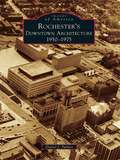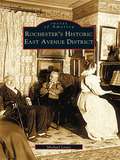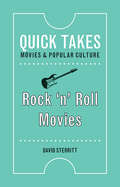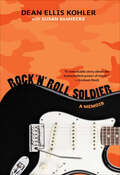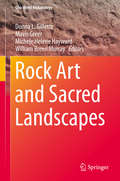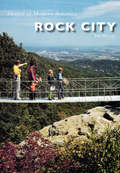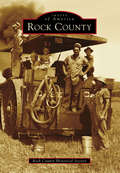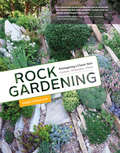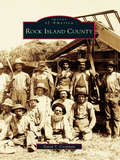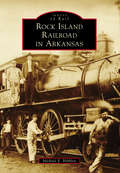- Table View
- List View
Robotics and Rehabilitation Intelligence: First International Conference, ICRRI 2020, Fushun, China, September 9–11, 2020, Proceedings, Part I (Communications in Computer and Information Science #1335)
by Honghai Liu Dalin Zhou Jianhua Qian Jiangtao CaoThis 2-volume set constitutes the refereed proceedings of 1st International Conference on Robotics and Rehabilitation Intelligence, ICRRI 2020, held in Fushun, China, in September 2020.The 56 full and 4 short papers were carefully reviewed and selected from 188 submissions. The papers are divided into the following topical sections. In the first volume: Rehabilitation robotics and safety; machine vision application; electric drive and power system fault diagnosis; robust stability and stabilization; intelligent method application; intelligent control and perception; smart remanufacturing and industrial intelligence; and intelligent control of integrated energy system. In the second volume: smart healthcare and intelligent information processing; human-robot interaction; multi-robot systems and control; robot design and control; robotic vision and machine intelligence; optimization method in monitoring; advanced process control in petrochemical process; and rehabilitation intelligence.
Robotics and Rehabilitation Intelligence: First International Conference, ICRRI 2020, Fushun, China, September 9–11, 2020, Proceedings, Part II (Communications in Computer and Information Science #1336)
by Honghai Liu Dalin Zhou Jianhua Qian Jiangtao CaoThis 2-volume set constitutes the refereed proceedings of 1st International Conference on Robotics and Rehabilitation Intelligence, ICRRI 2020, held in Fushun, China, in September 2020. The 56 full and 4 short papers were carefully reviewed and selected from 188 submissions. The papers are divided into the following topical sections. In the first volume: Rehabilitation robotics and safety; machine vision application; electric drive and power system fault diagnosis; robust stability and stabilization; intelligent method application; intelligent control and perception; smart remanufacturing and industrial intelligence; and intelligent control of integrated energy system. In the second volume: smart healthcare and intelligent information processing; human-robot interaction; multi-robot systems and control; robot design and control; robotic vision and machine intelligence; optimization method in monitoring; advanced process control in petrochemical process; and rehabilitation intelligence.
Robotics, Computer Vision and Intelligent Systems: First International Conference, ROBOVIS 2020, Virtual Event, November 4-6, 2020, and Second International Conference, ROBOVIS 2021, Virtual Event, October 27-28, 2021, Revised Selected Papers (Communications in Computer and Information Science #1667)
by Kurosh Madani Erdal Kayacan Péter GalambosThis volume constitutes the papers of two workshops which were held in conjunctionwith the First International Conference on Robotics, Computer Vision and Intelligent Systems,ROBOVIS 2020, Virtual Event, in November 4-6, 2020 and Second International Conference on Robotics, Computer Vision and Intelligent Systems,ROBOVIS 2021, Virtual Event, in October 25-27, 2021.The 11 revised full papers presented in this book were carefully reviewed and selectedfrom 53 submissions.
Robotics, Control and Computer Vision: Select Proceedings of ICRCCV 2022 (Lecture Notes in Electrical Engineering #1009)
by Richi Nayak Hariharan Muthusamy János BotzheimThis book presents select peer-reviewed papers from the International Conference on Robotics, Control, and Computer Vision (ICRCCV 2022). The contents focus on the latest research in the field of Robotics, their control, and computer vision in the context of robotics. The contributed papers have been arranged to give a flow to the reader. This book will be useful for students, researchers, and professionals from multidisciplinary fields such as mechanical engineering, electronics engineering, electrical engineering, computer science, and mathematics.
Robotics, Vision and Control: Fundamental Algorithms in MATLAB® (Springer Tracts in Advanced Robotics #147)
by Peter Corke Witold Jachimczyk Remo PillatThis textbook provides a comprehensive, but tutorial, introduction to robotics, computer vision, and control. It is written in a light but informative conversational style, weaving text, figures, mathematics, and lines of code into a cohesive narrative. Over 1600 code examples show how complex problems can be decomposed and solved using just a few simple lines of code. This edition is based on MATLAB® and a number of MathWorks® toolboxes. These provide a set of supported software tools for addressing a broad range of applications in robotics and computer vision. These toolboxes enable the reader to easily bring the algorithmic concepts into practice and work with real, non-trivial, problems. For the beginning student, the book makes the algorithms accessible, the toolbox code can be read to gain understanding, and the examples illustrate how it can be used. The code can also be the starting point for new work, for practitioners, students, or researchers, by writing programs based on toolbox functions. Two co-authors from MathWorks have joined the writing team and bring deep knowledge of these MATLAB toolboxes and workflows.
Robotics, Vision and Control: Fundamental Algorithms in Python (Springer Tracts in Advanced Robotics #146)
by Peter CorkeThis textbook provides a comprehensive, but tutorial, introduction to robotics, computer vision, and control. It is written in a light but informative conversational style, weaving text, figures, mathematics, and lines of code into a narrative that covers robotics and computer vision—separately, and together as robotic vision. Over 1600 code examples show how complex problems can be decomposed and solved using just a few simple lines of code. This edition is based on Python and is accompanied by fully open-source Python-based Toolboxes for robotics and machine vision. The new Toolboxes enable the reader to easily bring the algorithmic concepts into practice and work with real, non-trivial, problems on a broad range of computing platforms. For the beginning student the book makes the algorithms accessible, the Toolbox code can be read to gain understanding, and the examples illustrate how it can be used. The code can also be the starting point for new work, for practitioners, students, or researchers, by writing programs based on Toolbox functions, or modifying the Toolbox code itself.
Robots and Art
by Damith Herath Christian Kroos StelarcThe first compendium on robotic art of its kind, this book explores theintegration of robots into human society and our attitudes, fears and hopes ina world shared with autonomous machines. It raises questions about thebenefits, risks and ethics of the transformative changes to society that are the consequence of robotstaking on new roles alongside humans. It takes the reader on a journey into the world of the strange,the beautiful, the uncanny and the daring - and into the minds and works ofsome of the world's most prolific creators of robotic art. Offering anin-depth look at robotic art from the viewpoints of artists, engineers andscientists, it presentsoutstanding works of contemporary robotic art and brings together for the first time some of themost influential artists in this area in the last three decades. Starting froma historical review, this transdisciplinary work explores the nexus betweenrobotic research and the arts andexamines the diversityof robotic art, the encounter with robotic otherness, machine embodiment andhuman-robot interaction. Stories of difficulties, pitfalls and successes arerecalled, characterising the multifaceted collaborations across the diversedisciplines required to create robotic art. Although the book isprimarily targeted towards researchers, artists and students in robotics,computer science and the arts,its accessible style appeals to anyone intrigued by robots and the arts.
Robust Motion Detection in Real-Life Scenarios
by Ángel P. Pobil Ester Martínez-MartínThis work proposes a complete sensor-independent visual system that provides robust target motion detection. First, the way sensors obtain images, in terms of resolution distribution and pixel neighbourhood, is studied. This allows a spatial analysis of motion to be carried out. Then, a novel background maintenance approach for robust target motion detection is implemented. Two different situations are considered: a fixed camera observing a constant background where objects are moving; and a still camera observing objects in movement within a dynamic background. This distinction lies on developing a surveillance mechanism without the constraint of observing a scene free of foreground elements for several seconds when a reliable initial background model is obtained, as that situation cannot be guaranteed when a robotic system works in an unknown environment. Other problems are also addressed to successfully deal with changes in illumination, and the distinction between foreground and background elements.
Rochelle
by Carol HegbergThe Lincoln Highway through Rochelle was originally a Potawatomi Indian trail. In 1853, Robert P. Lane purchased land from Charlotte Bartholomew, Sheldon Bartholomew's widow, near the settlement known as Hickory Grove, and the community became officially known as Lane. After a hanging scandal, the citizens renamed their village Rochelle. From then, the town grew to the largest city in Ogle County. Rochelle's famous railroad park and the diamond (crossing of the Burlington Northern and Santa Fe Railroad and the Union Pacific Railroad) attract visitors throughout the year. The park's tourist center is located in a refurbished Standard Oil gas station. The Flagg Township Historical Museum offers times gone by in many forms in the 1884 city hall, which is on the National Register of Historic Places. Rochelle offers suburban amenities with the healthy atmosphere of the small town where actress Joan Allen grew up.
Rochester
by Shirley Willard Fulton County Historical SocietyThe county seat of Fulton County, Rochester is a small rural town in north-central Indiana. Its history includes many famous people. Despite the mistaken trivia game answer, Elmo Lincoln, the first Tarzan in 1918, was born in Rochester, Indiana, not New York. And John Chamberlain, famous modern sculptor, was born here too. Clyde Beatty, wild animal trainer extraordinaire, lived here while the Cole Brothers-Clyde Beatty Circus had its winter quarters in Rochester in the 1930s. For a community with such a small population, Rochester has harbored more than its share of famous people.
Rochester Labor and Leisure: Labor And Leisure (Images of America)
by Donovan A. ShillingRochester: Labor and Leisure is a visual celebration of the industrial strengths and the commercial successes of an earlier time. Located on the Genesee River, the city used the waterway to full advantage. Industries lined the riverbank, and the town thrived with enterprise and initiative. Rochester's vibrant and productive residents knew not only how to work hard but also how to enjoy life. With more than two hundred stunning photographs, Rochester: Labor and Leisure highlights the progress of the city's entrepreneurs, such as tobacco king William Kimball, oil tycoon Hiram Bond Everest, and museum operator Rattlesnake Pete. It reveals nightlife in the Gay Nineties and Front Street as it once was. It echoes the city's unforgettable one-hundredth birthday party and the acclaim received for building an aqueduct.
Rochester Leaders and Their Legacies (Images of America)
by Donovan A. ShillingRochester owes much to those who made it the exceptional andunique city it has become. Many of the civic, commercial, industrial, and entertainment leaders who brought fame and prosperity to the city are saluted in Rochester Leaders and Their Legacies. A gallery of rare photographs reveals the images of the founders and their legacies: McCurdy's, McFarlin's, Edwards, and Sibley's department stores; important businesses and products; and entertainment venues and memories. Here are glimpses of the nursery industry, Erie Canal, trolley days, downtown nightspots, theater performers, and recollections of unusual events, from fires and floods to the huge Elks Street Fair of 1899.
Rochester's Corn Hill: The Historic Third Ward (Images of America)
by Michael LeavyWhen Rochester experienced the explosive growth generated by the Erie Canal, what began as a pioneer neighborhood of cabins quickly became an impressive ward of mansions for the city's social hierarchy. Today's generation knows it as Corn Hill, but it is actually the old Third Ward, an extraordinary neighborhood that rivaled Charleston, Savannah, and Natchez in elegance and importance. Rochester's Corn Hill: The Historic Third Ward offers the first comprehensive pictorial history of this ruffled-shirt district from its humble beginnings, to its Victorian peak, through its eventual decline and subsequent rehabilitation into a landmark ward.
Rochester's Downtown
by Donovan A. ShillingDowntown Rochester is defined by Main Street, State Street, and the major crossroads of those streets. It is the core of one of New York State's most important cities. Rochester's Downtown recaptures the golden era when downtown bloomed as a mecca for daytime workers and shoppers and for an evening's entertainment at vibrant social centers. Rochester's Downtown celebrates the people of this great city as they progress from their early beginnings to create a dynamic business center. This excellent collection of images regenerates the excitement of riding the trolley, of watching a movie at the Palace or the Capitol, of window-shopping at the Duffy-Powers Store, and of tasting frosted malteds at Sibley's or warm doughnuts from the Mayflower Donut Shop or spoonfuls of roasted peanuts from Mr. Peanut Man. The narrative recalls Scrantom's as the place to buy books, Neisner's having the latest 78-rpm records, McCurdy's and Edward's with their special holiday displays, Eddie's Chop House for memorable dinners, and the Century Sweet Shop for after-theater sundaes.
Rochester's Downtown Architecture: 1950-1975 (Images of America)
by Daniel J. PalmerFollowing World War II, many American cities underwent a large-scale modernization to keep up with the changing times in business technology and architecture. With help from federal funding and planning, expansive and low-density modern projects replaced the crowded blocks of century-old buildings. State-of-the-art facilities featured large, open plazas that were the scenes of social and cultural events, attracting private developers to the city's core. Due to its participation in new policies of planning and the efforts of its strong preservation community, Rochester is today an interesting and sometimes perplexing mixture of densely packed, ornamental-19th-century buildings and monumentally scaled and architecturally stark projects of the modern era. Rochester's Downtown Architecture: 1950-1975 tells the story of the peak years of change to the built environment of Rochester's downtown.
Rochester's Historic East Avenue District
by Michael LeavyAmerican cities and towns have always prided themselves on their grand avenues. The social elite and industrial captains often transformed normal thoroughfares into magnificent promenades lined with mansions to showcase their wealth. Post-Civil War America experienced a burst of this activity, but Rochester, America's first true boomtown, had already set its sights on a grand avenue as early as 1840. The nouveau riche were anxious to establish a prestigious social colony befitting their stature. Using local and national architects, landscapers, and craftsmen, they transformed East Avenue from a crudely hacked pioneer lane into one of the grandest approaches to any city in the world. Although somewhat altered, it is still Rochester's most beautiful street and remains one of Monroe County's most spectacular features.
Rock 'n' Roll Movies (Quick Takes: Movies and Popular Culture)
by David SterrittRock ‘n’ Roll Movies presents an eclectic look at the many manifestations of rock in motion pictures, from teen-oriented B-movies to Hollywood blockbusters to avant-garde meditations to reverent biopics to animated shorts to performance documentaries. Acclaimed film critic David Sterritt considers the diverse ways that filmmakers have regarded rock ‘n’ roll, some cynically cashing in on its popularity and others responding to the music as sincere fans, some depicting rock as harmless fun and others representing it as an open challenge to mainstream norms.
Rock 'n' Roll Soldier: A Memoir
by Dean Ellis Kohler Susan VanHecke"During a time when none of us knew for sure if we would live or die, I came to know the true power of music."Dean Kohler is about to make it big—he's finally scored a national record deal! But his dreams are abruptly put on hold by the arrival of his draft notice. Now he's in Qui Nhon, Vietnam, serving as a military policeman. He keeps telling himself he's a musician, not a killer, and that he's lucky he's not fighting on the front lines. When Captain orders him to form a rock band, it's up to Dean to find instruments and players, pronto. Ingenuity and perseverance pay off and soon the band is traveling through treacherous jungle terrain to perform for troops in desperate need of an escape—even if it's only for three sets. And for Dean—who lives with death, violence, and the fear that anyone could be a potential spy (even his Vietnamese girlfriend)—the band becomes the one thing that gets him through the day. During one of the most controversial wars in recent American history, this incredible true story is about music and camaraderie in the midst of chaos.
Rock Art and Sacred Landscapes
by Donna L. Gillette Mavis Greer Michele Helene Hayward William Breen MurraySocial and behavioral scientists study religion or spirituality in various ways and have defined and approached the subject from different perspectives. In cultural anthropology and archaeology the understanding of what constitutes religion involves beliefs, oral traditions, practices and rituals, as well as the related material culture including artifacts, landscapes, structural features and visual representations like rock art. Researchers work to understand religious thoughts and actions that prompted their creation distinct from those created for economic, political, or social purposes. Rock art landscapes convey knowledge about sacred and spiritual ecology from generation to generation. Contributors to this global view detail how rock art can be employed to address issues regarding past dynamic interplays of religions and spiritual elements. Studies from a number of different cultural areas and time periods explore how rock art engages the emotions, materializes thoughts and actions and reflects religious organization as it intersects with sociopolitical cultural systems.
Rock City: The History Of Rock City Gardens (Images of Modern America)
by Tim HollisSince May 21, 1932, tourists have been making the trip to the top of Lookout Mountain to stroll through what pioneers as far back as the 1820s called “the rock city.” This collection of huge boulders in a wild array of shapes and sizes was developed as an attraction by Garnet Carter, the inventor of modern miniature golf, and his wife, Frieda, a devotee of European fairy tales. Rock City Gardens quickly became one of the most famous tourist attractions in the Southeast, especially after Carter started a program of painting advertisements on barn roofs. During the post–World War II baby-boom era, Rock City became even more of a destination with the additions of Fairyland Caverns and Mother Goose Village.
Rock County
by Rock County Historical SocietyRock County, located in the southwest corner of Minnesota, is proud to share its history through a pictorial journey of settlement, growth, and development. The county is, and has always been, an agricultural community. One of its outstanding features is the Sioux Quartzite cliff line visible to settlers who moved in or came through the area as well as today's residents and visitors. The cliff line is 120 feet high and stretches for about two miles. It was formed through the early glacier period and travels northwest through Rock County, past the South Dakota border, before going back underground. The rock was quarried and used in many of the homes and businesses in Luverne and other Rock County communities.
Rock Gardening: Reimagining a Classic Style
by Joseph TychonievichAHS Book Award winner Rock gardening —the art of growing alpines and other miniature plants in the company of rocks in order to recreate the look of a rugged mountaintop—has been surging in popularity. Time and space constraints, chronic drought in the American West, and a trend toward architectural plants are just a few of the reasons for the increased interest. Rock Gardening brings this traditional style to a new generation of gardeners. It includes a survey of gorgeous rock gardens from around the world, the techniques and methods specific to creating and maintaining a rock garden, and profiles of the top 50 rock garden plants.
Rock Island County (Images of America)
by David T. CoopmanThe history of Rock Island County, once known as the "farm implement capital of the world," starts well before that industry sprung up on the Mississippi River at a point where the river runs east to west. Fur trading, farming, mining, milling, and lumber all played a key role in the county's formation. As the railroad moved west, the first rail bridge over the Mississippi at Rock Island created a transportation hub and furthered the area's process of industrialization. This volume of vintage pictures looks at the county from the early 1800s, prior to its creation, through the mid-1960s. It illustrates the rich rural influence of the settlements, villages, and townships; the development of the cities and their industries, businesses, and educational and cultural centers; and how the people who worked the fields and factories made use of and enjoyed their leisure time.
Rock Island Railroad in Arkansas (Images of Rail)
by Michael E. HibblenFor nearly 80 years, the Rock Island was a major railroad in Arkansas providing passenger and freight services. A decline in rail travel after World War II and an increase in trucks hauling freight over government-subsidized interstates were among factors that left the railroad struggling. Efforts to merge with other railroads were stalled for years by federal regulators. The Rock Island filed for bankruptcy in 1975 and attempted a reorganization, but creditors wanted the assets liquidated, with a judge shutting it down in 1980. Most of the tracks that traversed the state were taken up, but a few relics, like the Little Rock passenger station and the Arkansas River bridge, remain as monuments to this once great railroad.
Rock My Wedding: Your Day Your Way
by Charlotte O'SheaThe definitive guide to planning your perfect wedding day, from the UK's most-loved, and multi-award-winning wedding website and podcast - Rock My Wedding. With friendly advice, tips, ideas and stunning photography, it's the perfect pre-wedding purchase for any couple!'The UK's most influential brand in the wedding industry'- Conclusion from an independent study carried out by Universal McCann, one of the world's leading ad networks.'Absolutely brimming with wedding inspiration' -- ***** Reader review'Every fiancé/fiancée needs this masterpiece' -- ***** Reader review'Beautiful and inspiring' -- ***** Reader review'Full of inspiration - this book is one every fiancé/fiancée should own to help them create their perfect wedding day' -- ***** Reader review******************************************************************************************************Just like you, your wedding day will be personal, one-of-a-kind, and completely unique. We're not here to tell you what you should do to make your day perfect, only that you can do it.Covering floral décor, table plans, lighting, photography, venues, outfits, food - as well as much more - this is your one-stop-shop to planning the perfect wedding for YOU.With advice and guidance on the individual aspects to consider when planning your wedding day - from where to begin and recommended questions to ask your suppliers, to plenty of alternative décor ideas - we hope that you'll find inspiration, reassurance and a little bit of escapism in these pages as you embark on planning one of the most special and joyful days of your lives.



